Wanbin Tang
6DMA-Aided Hybrid Beamforming with Joint Antenna Position and Orientation Optimization
Dec 22, 2024Abstract:This paper studies a sub-connected six-dimensional movable antenna (6DMA)-aided multi-user communication system. In this system, each sub-array is connected to a dedicated radio frequency chain and collectively moves and rotates as a unit within specific local regions. The movement and rotation capabilities of 6DMAs enhance design flexibility, facilitating the capture of spatial variations for improved communication performance. To fully characterize the effect of antenna position and orientation on wireless channels between the base station (BS) and users, we develop a field-response-based 6DMA channel model to account for the antenna radiation pattern and polarization. We then maximize the sum rate of multiple users, by jointly optimizing the digital and unit-modulus analog beamformers given the transmit power budget as well as the positions and orientations of sub-arrays within given movable and rotatable ranges at the BS. Due to the highly coupled variables, the formulated optimization problem is non-convex and thus challenging to solve. We develop a fractional programming-aided alternating optimization framework that integrates the Lagrange multiplier method, manifold optimization, and gradient descent to solve the problem. Numerical results demonstrate that the proposed 6DMA-aided sub-connected structure achieves a substantial sum-rate improvement over various benchmark schemes with less flexibility in antenna movement and can even outperform fully-digital beamforming systems that employ antenna position or orientation adjustments only. The results also highlight the necessity of considering antenna polarization for optimally adjusting antenna orientation.
Intra-symbol Differential Amplitude Shift Keying-aided Blind Detector for Ambient Backscatter Communication Systems
Aug 16, 2024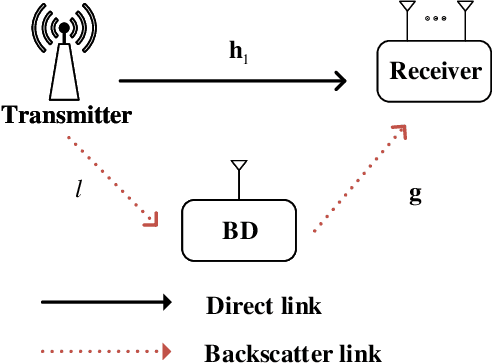
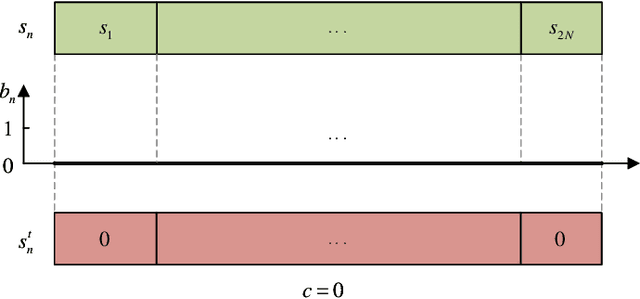
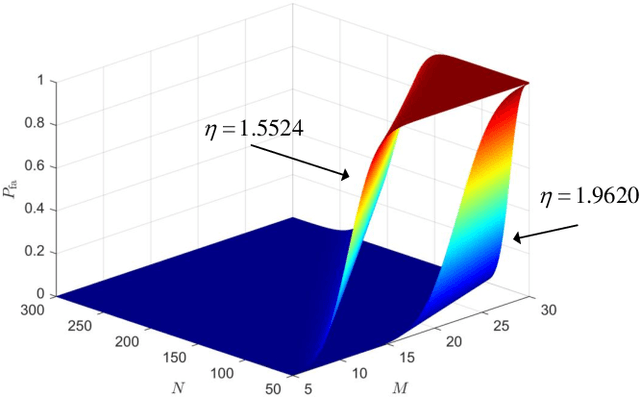
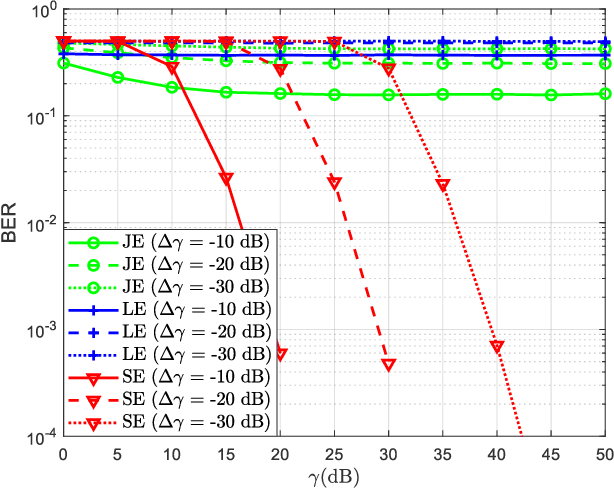
Abstract:Ambient backscatter communications (AmBC) are a promising technology for addressing the energy consumption challenge in wireless communications through the reflection or absorption of surrounding radio frequency (RF) signals. However, it grapples with the intricacies of ambient RF signal and the round-trip path loss. For traditional detectors, the incorporation of pilot sequences results in a reduction in spectral efficiency. Furthermore, traditional energy-based detectors are inherently susceptible to a notable error floor issue, attributed to the co-channel direct link interference (DLI). Consequently, this paper proposes a blind symbol detector without the prior knowledge of the channel state information, signal variance, and noise variance. By leveraging the intra-symbol differential amplitude shift keying (IDASK) scheme, this detector effectively redirects the majority of the DLI energy towards the largest eigenvalue of the received sample covariance matrix, thereby utilizing the second largest eigenvalue for efficient symbol detection. In addition, this paper conducts theoretical performance analyses of the proposed detector in terms of the false alarm probability, missed detection probability, and the bit-error rate (BER) lower bound. Simulation results demonstrate that the proposed blind detector exhibits a significant enhancement in symbol detection performance compared to its traditional counterparts.
Self-Evolving Wireless Communications: A Novel Intelligence Trend for 6G and Beyond
Apr 07, 2024Abstract:Wireless communication is rapidly evolving, and future wireless communications (6G and beyond) will be more heterogeneous, multi-layered, and complex, which poses challenges to traditional communications. Adaptive technologies in traditional communication systems respond to environmental changes by modifying system parameters and structures on their own and are not flexible and agile enough to satisfy requirements in future communications. To tackle these challenges, we propose a novel self-evolving communication framework, which consists of three layers: data layer, information layer, and knowledge layer. The first two layers allow communication systems to sense environments, fuse data, and generate a knowledge base for the knowledge layer. When dealing with a variety of application scenarios and environments, the generated knowledge is subsequently fed back to the first two layers for communication in practical application scenarios to obtain self-evolving ability and enhance the robustness of the system. In this paper, we first highlight the limitations of current adaptive communication systems and the need for intelligence, automation, and self-evolution in future wireless communications. We overview the development of self-evolving technologies and conceive the concept of self-evolving communications with its hypothetical architecture. To demonstrate the power of self-evolving modules, we compare the performances of a communication system with and without evolution. We then provide some potential techniques that enable self-evolving communications and challenges in implementing them.
Movable Antenna-Aided Hybrid Beamforming for Multi-User Communications
Apr 01, 2024Abstract:In this correspondence, we propose a movable antenna (MA)-aided multi-user hybrid beamforming scheme with a sub-connected structure, where multiple movable sub-arrays can independently change their positions within different local regions. To maximize the system sum rate, we jointly optimize the digital beamformer, analog beamformer, and positions of subarrays, under the constraints of unit modulus, finite movable regions, and power budget. Due to the non-concave/non-convex objective function/constraints, as well as the highly coupled variables, the formulated problem is challenging to solve. By employing fractional programming, we develop an alternating optimization framework to solve the problem via a combination of Lagrange multipliers, penalty method, and gradient descent. Numerical results reveal that the proposed MA-aided hybrid beamforming scheme significantly improves the sum rate compared to its fixed-position antenna (FPA) counterpart. Moreover, with sufficiently large movable regions, the proposed scheme with sub-connected MA arrays even outperforms the fully-connected FPA array.
Near-Field Wideband Secure Communications: An Analog Beamfocusing Approach
Nov 29, 2023



Abstract:In the rapidly advancing landscape of 6G, characterized by ultra-high-speed wideband transmission in millimeter-wave and terahertz bands, our paper addresses the pivotal task of enhancing physical layer security (PLS) within near-field wideband communications. We introduce true-time delayer (TTD)-incorporated analog beamfocusing techniques designed to address the interplay between near-field propagation and wideband beamsplit, an uncharted domain in existing literature. Our approach to maximizing secrecy rates involves formulating an optimization problem for joint power allocation and analog beamformer design, employing a two-stage process encompassing a semi-digital solution and analog approximation. This problem is efficiently solved through a combination of alternating optimization, fractional programming, and block successive upper-bound minimization techniques. Additionally, we present a low-complexity beamsplit-aware beamfocusing strategy, capitalizing on geometric insights from near-field wideband propagation, which can also serve as a robust initial value for the optimization-based approach. Numerical results substantiate the efficacy of the proposed methods, clearly demonstrating their superiority over TTD-free approaches in fortifying wideband PLS, as well as the advantageous secrecy energy efficiency achieved by leveraging low-cost analog devices.
Robust Transceiver Design for Covert Integrated Sensing and Communications With Imperfect CSI
Aug 29, 2023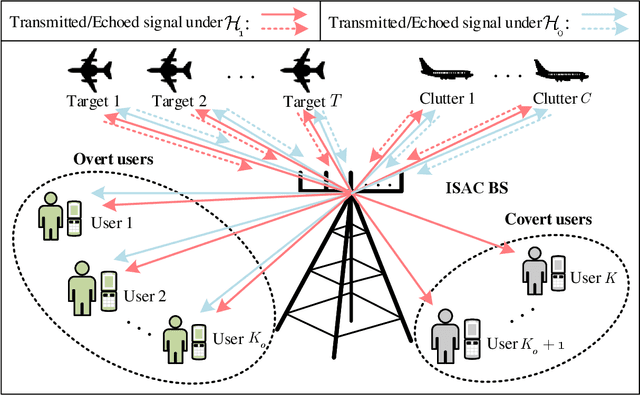
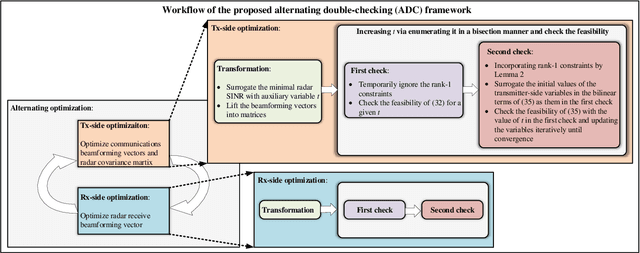
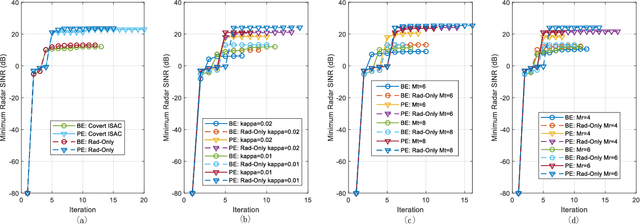
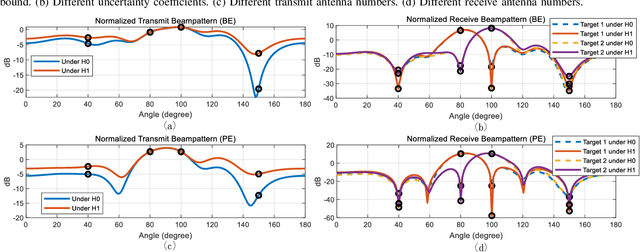
Abstract:We propose a robust transceiver design for a covert integrated sensing and communications (ISAC) system with imperfect channel state information (CSI). Considering both bounded and probabilistic CSI error models, we formulate worst-case and outage-constrained robust optimization problems of joint trasceiver beamforming and radar waveform design to balance the radar performance of multiple targets while ensuring communications performance and covertness of the system. The optimization problems are challenging due to the non-convexity arising from the semi-infinite constraints (SICs) and the coupled transceiver variables. In an effort to tackle the former difficulty, S-procedure and Bernstein-type inequality are introduced for converting the SICs into finite convex linear matrix inequalities (LMIs) and second-order cone constraints. A robust alternating optimization framework referred to alternating double-checking is developed for decoupling the transceiver design problem into feasibility-checking transmitter- and receiver-side subproblems, transforming the rank-one constraints into a set of LMIs, and verifying the feasibility of beamforming by invoking the matrix-lifting scheme. Numerical results are provided to demonstrate the effectiveness and robustness of the proposed algorithm in improving the performance of covert ISAC systems.
Energy-Efficient UAV Communications: A Generalised Propulsion Energy Consumption Model
Feb 17, 2022

Abstract:This paper proposes a generalised propulsion energy consumption model (PECM) for rotary-wing ummanned aerial vehicles (UAVs) under the consideration of the practical thrust-to-weight ratio (TWR) with respect to the velocity, acceleration and direction change of the UAVs. To verify the effectiveness of the proposed PECM, we consider a UAV-enabled communication system, where a rotary-wing UAV serves multiple ground users as an aerial base station. We aim to maximize the energy efficiency (EE) of the UAV by jointly optimizing the user scheduling and UAV trajectory variables. However, the formulated problem is a non-convex fractional integer programming problem, which is challenging to obtain its optimal solution. To tackle this, we propose an efficient iterative algorithm by decomposing the original problem into two sub-problems to obtain a suboptimal solution based on the successive convex approximation technique. Simulation results show that the optimized UAV trajectory by applying the proposed PECM are smoother and the corresponding EE has significant improvement as compared to other benchmark schemes.
UAV-Enabled Cooperative Jamming for Covert Communications
Jan 19, 2021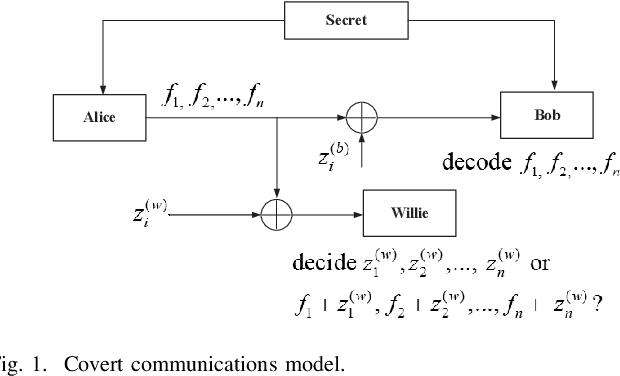
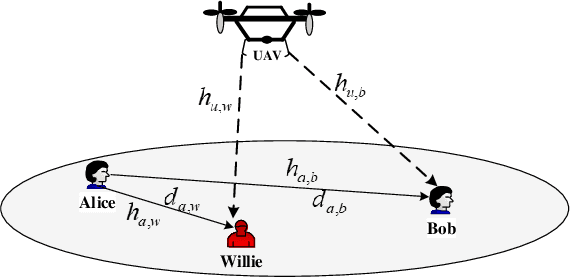

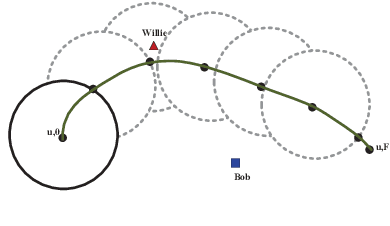
Abstract:In this paper a novel unmanned aerial vehicle aided (UAV) cooperative jamming scheme is proposed for covert communications. We first analyze the detection performance of the system to obtain the minimum error detection probability of the eavesdropper and then determine the transmission rate as the objective function by analyzing the transmission outage probability of the communication. The problem formulate is non-convex that is difficult to solve. To solve this, two efficient algorithms are proposed for general signal to interference plus noise ratio (SINR) and high SINR, respectively. The first algorithm applying the block coordinate descent (BCD) to decompose the problem into two subproblems and then solve them by successive convex approximation (SCA). For the second algorithm, we use a geometric method(GM) based on the Apollonius of Sphere to solve the optimization problem. The proposed scheme can enhance the covert performance significantly. Simulations verify that the proposed joint design can enhance the covert transmission rate of the considered system as compared to the benchmark schemes.
 Add to Chrome
Add to Chrome Add to Firefox
Add to Firefox Add to Edge
Add to Edge